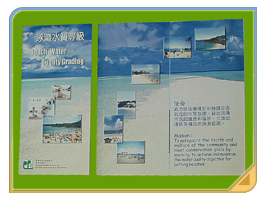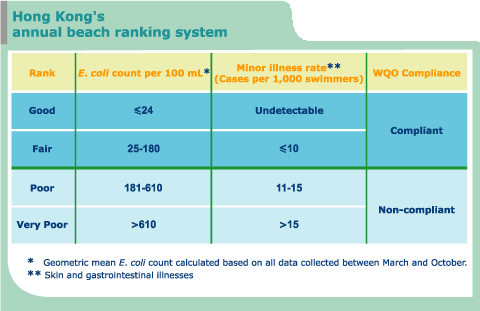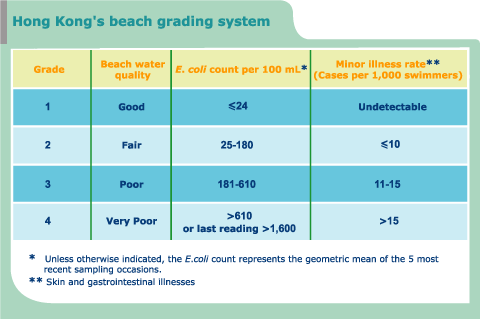The EPD uses two separate systems to help beach users get a wider picture about beach water quality. The first is the annual ranking system, which is designed to give a general summary of the water quality at every beach across the bathing season, from March to October. Beaches were ranked using an annual ranking system when the EPD first took over the monitoring programme in 1986. On the other hand, the grading system, which came into operation in 1987, is designed to present recent, short-term information about beach water quality, based on sampling over the past few weeks. Both systems have undergone changes and improvements over the years and gradually developed into the forms that are used today.
| Ranking and Grading Hong Kong's Beaches |  |

|
Each year, the EPD sorts Hong Kong's beaches into rankings to reflect the overall quality of beach water across the bathing season (March to October). The most important distinction is whether or not individual beaches met the WQO. The key figure here is 180 per 100 mL, the upper limit for E. coli bacteria in 100 mL of sea water. Beaches whose geometric mean across the swimming season is more than 180 do not meet the WQO.
Those beaches that do meet the WQO (and most of Hong Kong's beaches are in this category) are then further ranked to reflect the quality of their beach water. The best beaches are ranked as 'Good', while those beaches with a higher geometric mean are ranked 'Fair'. In the same way, beaches that have not met the WQO are also further categorized into two rankings: 'Poor' and 'Very Poor'. This fourfold ranking system is designed to help beach users know which beaches have consistently high or low water quality. It also provides the public and the Government with helpful information on trends of improvement or deterioration over the longer term.

The beach ranking system has been developed into its current form over time. In the early days, beaches were ranked into four categories: 'Good', 'Acceptable', 'Marginally acceptable', and 'Unacceptable', based on their percentage of compliance with the Hong Kong water quality standards of the day. Once the EPD's own studies were completed in the late 1980s, however, the system was revised and linked to health risks. This involved a change in the category labels, which between 1990 and 1992 evolved into those used today.
The beach grading system was designed to complement the beach annual ranking system, and give beach users up-to-date information about the water quality of Hong Kong's beaches at any given time of the year. The beach grading score for any individual beach is worked out by taking the geometric mean E. coli levels of the five most recent samples taken from that beach. Because most gazetted beaches are sampled three times per month or more, a beach grading score provides a good snapshot of beach water quality over the current month.
When the beach grading system was first introduced in July 1987, it divided beaches into three categories: 'A' (Good), 'B' (Acceptable) and 'C' (Poor). The early criteria for grading were based on 1977 WHO criteria which, as mentioned earlier, were not based on epidemiological studies and were not specifically linked with health risks to swimmers. Following the EPD's own studies in the late 1980s and its development of health-risk based water quality objectives, a revised four-tier grading system was introduced in 1990, numbered from 1 to 4 and labelled 'Good', 'Fair', 'Acceptable', and 'Poor'.
In 1992, the classification system was further refined into what is the current system. On the basis of their scores, beaches now fall into one of four grades: Grade 1 (Good), Grade 2 (Fair), Grade 3 (Poor), and Grade 4 (Very Poor). These labels should not be confused with those of the beach annual ranking system, which measures water quality across an entire season. For example, a beach may have some periods when it is graded 'Good', while still being ranked 'Fair' for the bathing season as a whole.
A further significant change was made in 1999. Since then, whenever
a single beach water sample shows an E. coli level exceeding 1,600 per
100 mL, this reading overrides the geometric mean figure for the beach
and instead triggers an immediate Grade 4 rating. Sudden high levels
of E. coli indicate a potential health risk, and this system is designed
to make sure they are not disguised by a low geometric mean. Such a level
probably suggests a period of exceptionally heavy rainfall or an isolated
pollution incident, for which immediate action needs to be taken.
